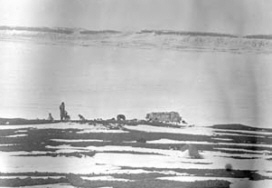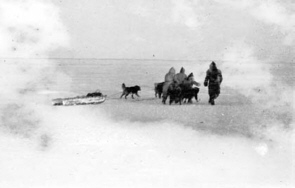|
FIRST PEOPLE, FIRST ALASKANS
Note: Pictures shown are for visual imagery only in an
effort to depict the land and conditions the first Alaskans probably went
through as they crossed the Bering land bridge.
 The late Pleistocene and early Holocene periods provide a record of the first
entries of humans into the Americas and consequently, are associated with one of
the great migratory events of human history --- the peopling of the New World.
The descendants of the "First Alaskans" who created early habitation sites went
on to spread across North and South America, eventually reaching Tierra del
Fuego about 10,700 years ago. As far as Native Americans are concerned, all
roads lead back to Alaska. Though a harsh wilderness, it is the original
homeland in the New World. The late Pleistocene and early Holocene periods provide a record of the first
entries of humans into the Americas and consequently, are associated with one of
the great migratory events of human history --- the peopling of the New World.
The descendants of the "First Alaskans" who created early habitation sites went
on to spread across North and South America, eventually reaching Tierra del
Fuego about 10,700 years ago. As far as Native Americans are concerned, all
roads lead back to Alaska. Though a harsh wilderness, it is the original
homeland in the New World.
Eskimos settled what is now known as Alaska nearly 2,500 years ago. The
natives had become people who lived inland. Aleuts, Tlingits, and Haidas
preferred life near the Pacific. The Inuits stayed to the north and northwest,
where the Artic Ocean provided food in the summer and fall. Athabaskans settled
among the hills and valleys.
Continuing contact existed over the millennia between Alaskan Natives and the
Old World of northeast Asia. Ideas, goods, and often people moved back and forth
across the Bering Strait that separates Alaska from Siberia. That pursuit
continued as glaciers melted and a shallow sea took the place of the land
bridge. But the sea did little to stem the exchange of ideas, people, and items
of trade. The great migrations of fish and wildlife continued, and the lands
that were once joined retained a common character. The people of Beringia were
united by language, traditions, and environment.
 Well into the nineteenth century
Siberian raiders were frequent visitors to the shores of what is now the Bering
land bridge on the Seward Peninsula. Peaceful contact was also frequent. For
instance, one of the favored items that passed across the Bering Strait in
peaceful times was iron, which reached as far east as Hudson's Bay - a symbol of
Alaska's unique connection to the Old World that existed for thousands of years
prior to the Viking's discovery of North America. Well into the nineteenth century
Siberian raiders were frequent visitors to the shores of what is now the Bering
land bridge on the Seward Peninsula. Peaceful contact was also frequent. For
instance, one of the favored items that passed across the Bering Strait in
peaceful times was iron, which reached as far east as Hudson's Bay - a symbol of
Alaska's unique connection to the Old World that existed for thousands of years
prior to the Viking's discovery of North America.
By the time the first Europeans arrived in the mid-1700s, they found several
diverse cultures living in Alaska - whalers inhabited the treeless tundra along
the coast, and nomadic caribou hunters roamed the forested interior along the
Yukon River. Alaska's panhandle was home to members of the Tlingit, Tsimshian
and Haida groups, who lived in a lush coastal environment.
These First People... these First Alaskans, occupied the land for
thousands of years without degrading the landscape or exhausting the land's natural
resources. They lived a rather peaceful existence until Russian and
British explorers began navigating the area in the early 1700's. Their
arrival began Alaska's modern history.
|